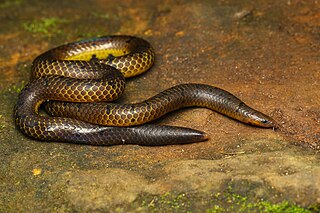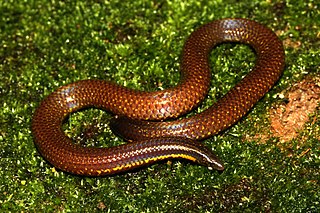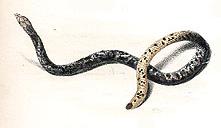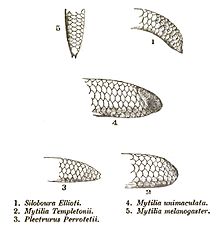
Platyplectrurus madurensis, commonly known as the Travancore Hills thorntail snake, Palni purple-brown worm thorntail snake, or Madurai shield-tail snake, is a species of uropeltid snake. It is found in southern India and, depending on the source, Sri Lanka.
Platyplectrurus trilineatus, commonly known as the tri-striped shield-tail snake or the lined thorntail snake, is a species of uropeltid snake endemic to the Western Ghats of Southern India. Like most other shieldtail snakes, it is presumed to be a nocturnal, fossorial snake inhabiting evergreen forests. A very rare snake, about which nothing is known in terms of live colouration and natural history.

Plectrurus aureus, commonly known as the Kerala burrowing snake or Kerala shield-tail snake, is a species of uropeltid snake endemic to India.
Rhinophis oxyrhynchus, also known as Schneider's earth snake or Schneider's shieldtail, is a species of uropeltid snake endemic to Sri Lanka.
Uropeltis ceylanica is a species of nonvenomous shieldtail snake in the family Uropeltidae. The species is endemic to the Western Ghats of South India. No subspecies are currently recognized as being valid, but the presence of several synonyms, many recently resurrected, calls for further taxonomic studies of this species complex. It is a burrowing snake with a pointy head equipped to penetrate the soil. It has a thick tail which looks as if it has been cut at an angle. In Kerala it's called iru thala moori, which means two headed organism, as the tail end looks like another head. It primarily eats earth worms.
Uropeltis dindigalensis, commonly known as the Dindigul uropeltis and the Sirumalai Hills earth snake, is a species of snake in the family Uropeltidae. The species is endemic to Sirumalai and surrounding hill ranges of the southern Eastern Ghats, in Dindigul district of Tamil Nadu state in South India.

Uropeltis ellioti, commonly known as Elliot's earth snake and Elliot's shieldtail, is a species of snake in the family Uropeltidae. The species is endemic to India.
Uropeltis ocellata is a species of non-venomous shieldtail snake in the family Uropeltidae. The species is indigenous to southern India. There are no subspecies that are recognized as being valid.

Uropeltis phipsonii, commonly known as Phipson's earth snake and Phipson's shieldtail, is a species of snake in the family Uropeltidae. The species is endemic to India.

Uropeltis pulneyensis, commonly known as the Indian earth snake and the Palni shieldtail, is a species of snake in the family Uropeltidae. The species is endemic to the Western Ghats of India.

Uropeltis rubromaculata is a species of nonvenomous shieldtail snake in the family Uropeltidae. The species is endemic to southern India. There are no subspecies that are recognized as being valid.
Uropeltis is a genus of nonvenomous shield-tail snakes endemic to Peninsular India. As of 2022, 26 species are recognized as being valid.

Plectrurus is a genus of nonvenomous shield tail snakes endemic to the Western Ghats of South India. Currently, three species are recognized. They inhabit high elevation montane Shola forests and are usually found under fallen logs and rocks. Some species are rare while some are quite common in their range.

Rhinophis is a genus of nonvenomous shield-tail snakes found in Sri Lanka and South India. Currently, 24 species are recognized in this genus. Of the 24 species, 18 are endemic to Sri Lanka, while six are endemic to South India.

Melanophidium is a genus of nonvenomous shield-tail snakes endemic to the Western Ghats of India. These species are identifiable by having a mental groove in their chin shields. Currently, four species are recognized, including one newly described species.
Teretrurus rhodogaster is a species of nonvenomous shield tail snake, endemic to the Western Ghats of India. It is known as Wall's shield-tail snake, the Palni Mountain burrowing snake, or the red-bellied shield-tail snake.
Rhinophis erangaviraji, also known commonly as Eranga Viraj's shieldtail snake, is a species of snake in the family Uropeltidae. The species is endemic to Sri Lanka, where it was discovered in the Rakwana area of Matara District.

Rhinophis goweri, also known as Gower's shieldtail snake, is a recently described, little-known species of snake of the family Uropeltidae. It is endemic to the Eastern Ghats of Tamil Nadu in South India. As per the IUCN it is a Critically Endangered snake species.

Uropeltis madurensis, also known commonly as the Madura earth snake and the Madurai shieldtail, is an endangered species of small, fossorial, nonvenomous snake of the family Uropeltidae. The species is endemic to the Western Ghats of South India.












